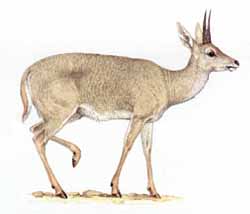English: Grey Rhebok; French: Rhebuck; Afrikaans: Vaal Riebok; Sotho: Pshiatla; Tswana: Hhela, Lehele; Zulu: Iliza, Ilinxala.
 |
Former distribution: As now.
Present distribution: Cape Province in South Africa; eastern parts of Orange Free State; Lesotho, Natal, Transvaal and Swaziland.
Behaviour: Preferred habitat: high grass plateaux; they live in small family groups of about 12; grazers and active mainly diurnally, needing water once a day. Predators are very few due to the cultivated areas close-by; they probably include baboons, jackals; caracals prey on the pups.
Population status: Stable. Estimated numbers: no records.
Brief notes:
Body weight: 20-30 kg
Head and body length: 110-125 cm
Tail length: 10-20 cm
Shoulder height: 70-80
Gestation period: 261 days
Maximum age: 14 years
Trophy: Record SCI: 26 3/8 score, 1981 RSA, T.W. SOBOSLAY M.D.; average 18 score. RW’s: 11 1/2″, RSA, LORD KYLSANT.
Hunting methods: Stalking, on horseback.
Remarks: Only males carry horns. Hunting laws and excellent game management have led to a considerable increase of the Grey Rhebok populations; these were also introduced to the Addo and Bontebok national parks in South Africa.






